Indonesia's biofuel program to bring 2.5 million jobs in three years time
 In the developing world, biofuels mean jobs. Earlier, Indonesia already hailed its biofuel program as a strategy to alleviate poverty, but remained vague about the actual number of jobs it will bring. Today, the Indonesian government became more concrete and announced that its green energy crash program will generate 2.5 million jobs in under three years time. For a country with mass unemployment and poverty, this is indeed a great boost.
In the developing world, biofuels mean jobs. Earlier, Indonesia already hailed its biofuel program as a strategy to alleviate poverty, but remained vague about the actual number of jobs it will bring. Today, the Indonesian government became more concrete and announced that its green energy crash program will generate 2.5 million jobs in under three years time. For a country with mass unemployment and poverty, this is indeed a great boost.As part of an expanded poverty alleviation campaign, the Indonesian government would prioritize two programs to reach the goal of creating 15 million jobs before 2010: 'people empowerment' and 'biofuels'. Coordinating Minister for the People's Welfare Aburizal Bakrie, claims that the 'people empowerment program' had actually been running since 1998 in 34,200 villages across the country. The program is expected to generate jobs for 12.5 million people, assuming each project will absorb 250 people in a specific area for three years, said Aburizal. "The projects work, but we need to extend them to 50,000 more villages by 2009," he said after a cabinet meeting Thursday. "The types of projects are determined based on local conditions."
The remaining 2.5 million jobs are expected to come as the government opens plantations to support its biofuel program. Critics have called the anti-poverty projects ineffective, pointing to the steady rise in the number of poor people over the past few years. But Aburizal said that without the programs, poverty rates would have been even higher. "We hope that the coordination between the relevant Cabinet ministers can go better. We have agreed that 20 percent of the total state budget allocated for poverty alleviation will go to these two programs," he said.
The government has increased next year's poverty alleviation budget to 51 trillion rupiah (€4.4 billion/US$5.6 billion ), from 43 trillion rupiah (€3.7billion/US$4.7 billion) in 2006 [entry ends here].
 ethanol :: biodiesel :: biomass :: bioenergy :: biofuels :: sustainability :: social justice :: jobs :: Indonesia ::
ethanol :: biodiesel :: biomass :: bioenergy :: biofuels :: sustainability :: social justice :: jobs :: Indonesia :: Article continues
 --------------
--------------
 Taiwan's Feng Chia University has succeeded in boosting the production of hydrogen from biomass to 15 liters per hour, one of the world's highest biohydrogen production rates, a researcher at the university said Friday. The research team managed to produce hydrogen and carbon dioxide (which can be captured and stored) from the fermentation of different strains of anaerobes in a sugar cane-based liquefied mixture. The highest yield was obtained by the Clostridium bacterium.
Taiwan's Feng Chia University has succeeded in boosting the production of hydrogen from biomass to 15 liters per hour, one of the world's highest biohydrogen production rates, a researcher at the university said Friday. The research team managed to produce hydrogen and carbon dioxide (which can be captured and stored) from the fermentation of different strains of anaerobes in a sugar cane-based liquefied mixture. The highest yield was obtained by the Clostridium bacterium.


 Via
Via  Not long ago, India set a 'world record' when
Not long ago, India set a 'world record' when  Japan is an active player when it comes to investing in 'Clean Development Mechanism' projects in the South (see the
Japan is an active player when it comes to investing in 'Clean Development Mechanism' projects in the South (see the 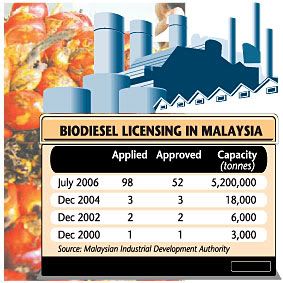 Two contradicting messages are coming out of Malaysia: on the one hand, the government has been issueing licence after licence for the construction of not less than 52 biodiesel plants, but on the other hand, it announces that the country has virtually no land left for the establishment of new oil palm plantations which are supposed to deliver the feedstock for the biodiesel.
Two contradicting messages are coming out of Malaysia: on the one hand, the government has been issueing licence after licence for the construction of not less than 52 biodiesel plants, but on the other hand, it announces that the country has virtually no land left for the establishment of new oil palm plantations which are supposed to deliver the feedstock for the biodiesel. Carbon is becoming an ever increasing problem. We already knew that CO2 emissions cause global warming, but strategies and targets to reduce them were designed and are up and running (carbon trading). The real drama is that
Carbon is becoming an ever increasing problem. We already knew that CO2 emissions cause global warming, but strategies and targets to reduce them were designed and are up and running (carbon trading). The real drama is that 
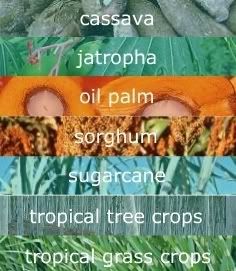 We are rapidly progressing towards a green energy future in which developing nations -- more particularly countries in the tropics and the sub-tropics -- are playing an ever increasing role. Because of this, we will begin to hear more and more about tropical energy crops that can be used to make solid and liquid biofuels.
We are rapidly progressing towards a green energy future in which developing nations -- more particularly countries in the tropics and the sub-tropics -- are playing an ever increasing role. Because of this, we will begin to hear more and more about tropical energy crops that can be used to make solid and liquid biofuels. Pune, India - With his deepset eyes and closely cropped hair Vinod Khosla has the mien of a monk. The appellation may not be befitting Silicon Valley’s ace ventura, who co-founded Sun Microsystems and later invested bigtime in Google and Amazon - and, in the process, pocketed billions of dollars, but it wouldn’t be out of place either: Khosla now dons the garb of an evangelist — an ethanol evangelist to be precise.
Pune, India - With his deepset eyes and closely cropped hair Vinod Khosla has the mien of a monk. The appellation may not be befitting Silicon Valley’s ace ventura, who co-founded Sun Microsystems and later invested bigtime in Google and Amazon - and, in the process, pocketed billions of dollars, but it wouldn’t be out of place either: Khosla now dons the garb of an evangelist — an ethanol evangelist to be precise.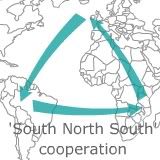 Things are speeding up, along the lines we have been predicting: European countries will collaborate with green energy leaders (Brazil, Nigeria, Malaysia, Indonesia), to launch large-scale biofuels and bioenergy production projects in the global South, and more particularly in Africa. Prototypically, in such 'South-North-South' agreements, Europe delivers capital and market access, the green energy leader brings in knowledge and technical expertise, and the developing world partner offers agro-ecologic advantages, land, labor and law. Not long ago,
Things are speeding up, along the lines we have been predicting: European countries will collaborate with green energy leaders (Brazil, Nigeria, Malaysia, Indonesia), to launch large-scale biofuels and bioenergy production projects in the global South, and more particularly in Africa. Prototypically, in such 'South-North-South' agreements, Europe delivers capital and market access, the green energy leader brings in knowledge and technical expertise, and the developing world partner offers agro-ecologic advantages, land, labor and law. Not long ago, 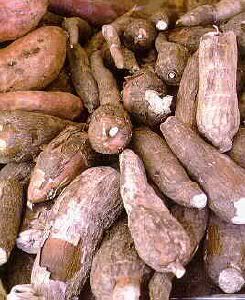 Nigeria has been working on a biofuels program for a very long time, and a first large-scale ethanol project involving sugar cane in the country's North-West shows the green energy industry's impressive job creation potential (the particular program in question is projected to bring in
Nigeria has been working on a biofuels program for a very long time, and a first large-scale ethanol project involving sugar cane in the country's North-West shows the green energy industry's impressive job creation potential (the particular program in question is projected to bring in 
 Earlier, we reported about
Earlier, we reported about  Greenhouse gas emissions in the Netherlands fell by around 2 percent in 2005 from a year earlier and were at approximately the same level they were in 1990, the
Greenhouse gas emissions in the Netherlands fell by around 2 percent in 2005 from a year earlier and were at approximately the same level they were in 1990, the  We are fascinated by practical South-South exchanges, and the field of bioenergy and biofuels is one where the sharing of experiences, knowledge and technology between developing nations is really speeding up.
We are fascinated by practical South-South exchanges, and the field of bioenergy and biofuels is one where the sharing of experiences, knowledge and technology between developing nations is really speeding up.
 Whenever we hear about the Democratic Republic of Congo, formerly known as Zaire, we read superlatives: the country has huge reserves of mineral wealth (gold, diamond, coltan, copper, uranium...), its vast land resources could make it the breadbasket of Central Africa, the country's main river, the Congo, is the second biggest on earth, hosting the second largest pristine rainforest after the Amazon, and when it comes to politics, the country has been in the hands of ruthless dictators for more than 3 decades. In Congo, everything is big, and so are the country's problems.
Whenever we hear about the Democratic Republic of Congo, formerly known as Zaire, we read superlatives: the country has huge reserves of mineral wealth (gold, diamond, coltan, copper, uranium...), its vast land resources could make it the breadbasket of Central Africa, the country's main river, the Congo, is the second biggest on earth, hosting the second largest pristine rainforest after the Amazon, and when it comes to politics, the country has been in the hands of ruthless dictators for more than 3 decades. In Congo, everything is big, and so are the country's problems.
 Despite sugar cane being one of the world's most important agricultural crops, it is surprising to see how little research there actually is on the plant's biochemistry and the applications its molecules could bring. Only now, with the advent of the concepts of 'biorefineries' and 'green chemistry', scientists are beginning to focus attention on this potential. With high oil prices, alternatives for petro-chemicals are being sought, urgently, and sugar cane might bring us a far way.
Despite sugar cane being one of the world's most important agricultural crops, it is surprising to see how little research there actually is on the plant's biochemistry and the applications its molecules could bring. Only now, with the advent of the concepts of 'biorefineries' and 'green chemistry', scientists are beginning to focus attention on this potential. With high oil prices, alternatives for petro-chemicals are being sought, urgently, and sugar cane might bring us a far way.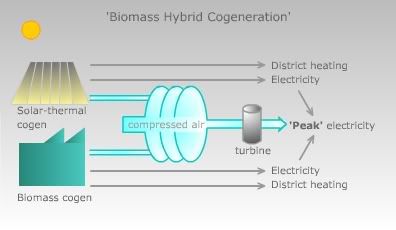
 China and Germany have two things in common: they are energy- intensive export- nations that are leading the transition to renewables, and their agricultural and forestry sectors generate vast amounts of biomass 'waste' that could be used to make liquid biofuels. Wood waste, corn stover, wheat straw, beet tops, rice straw... the flow is diverse and massive. Germany could get some 10% of its liquid fuel needs out of its wood waste stream alone; China might be able to make up to 35% of theirs from similar biomass.
China and Germany have two things in common: they are energy- intensive export- nations that are leading the transition to renewables, and their agricultural and forestry sectors generate vast amounts of biomass 'waste' that could be used to make liquid biofuels. Wood waste, corn stover, wheat straw, beet tops, rice straw... the flow is diverse and massive. Germany could get some 10% of its liquid fuel needs out of its wood waste stream alone; China might be able to make up to 35% of theirs from similar biomass.






Saturday, September 09, 2006
China and India sign strategic memorandum on science & technology cooperation
The agreement is important because energy, climate change, biotechnology and agronomy are high on the agenda. The cooperation is based on both public interest and pure science and technology 'pillars':
- Environment and energy: the two governments hope to collaborate on solving environmental problems by exchanging India and China's unique experiences amidst rising energy prices. Cooperation on research into alternative transport energies to combat energy insecurity and pollution in urban areas will be of strategic importance.
- Biotechnology and agronomy: research into genomics, meteorology and biomass technologies have been singled out as concrete fields for cooperation. India has a lot to offer in agronomic sciences, considering the fact that the contribution of agriculture in India's gross domestic product (GDP) at 24% was higher than China's 14%, Mr Sibal said.
- Climate change: India would stand to gain from China's expertise in climate change mitigation strategies (even though it is not clear which 'strategies' are being referred to here)
- Nanotechnology: a "Nano-Science Forum" will be created, with research into applications in the field of energy technology being one component
The comprehensive agreement further foresees in exchanges in the fields of software and space technology, amongst other sectors. Science, Tech and Earth Sciences minister Kapil Sibal summarized the vision behind the agreement thus:Sibal further noted that Sino-Indian trade has already reached US$18 billion. China is destined to become India's largest trading partner. He added that China has a population of 1.3 billion and that India's has reached 1.1 billion. "If you add the association of Southeast Asian nations (ASEAN), the population of this region will touch 3 billion which means that we constitute half of the world's population." "So we have the market and we have the manpower. What we need is the technology. So let us start an Indo-China technology partnership. Let the strategic partnership for friendship become a strategic partnership for science and technology."
More information:
Article continues
posted by Biopact team at 4:54 PM 0 comments links to this post
